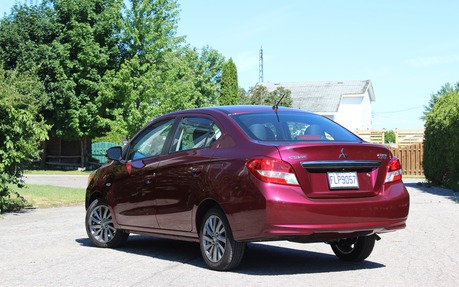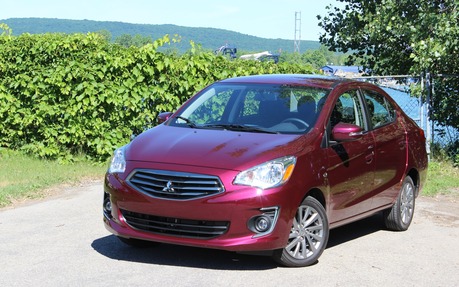2017 Mitsubishi Mirage G4: Slowly, But Surely
The minicar segment is as small as the cars that populate it, yet Mitsubishi likely figured it was on to something when it introduced the Mirage hatchback on the Canadian market. At the time, it was to compete with the Chevrolet Spark, the Fiat 500 and the smart fortwo. No sweat.
After all, the Mirage offered room the five—well, there are five seat belts, anyway—and a very fuel-efficient engine, backed by a solid warranty. Why buy a used car when you can get a new one for the same price?
Six months later, the Nissan Micra arrived, and completely overshadowed the little Mitsubishi with its smiling face and ultra-low, $9,995 price tag. All of a sudden, the Mirage’s shortcomings couldn’t justify the $2,500 price difference between the two minicars. The arrival of the second-generation Spark in 2016, which was also introduced with an MSRP under ten grand, also left the Mirage in the dust.
Ah, but Mitsubishi has retaliated with the introduction of the Mirage G4, the only four-door sedan in its class, along with a bunch of improvements and some minor styling tweaks for the hatchback.
Compared to the latter, the 2017 Mitsubishi Mirage G4 gets a wheelbase stretch of 100 millimetres and is 510 mm longer overall. That extra girth translates into rear-seat legroom, of which the G4 has plenty of. In the world of minicars, this is clearly the most family-friendly choice. The trunk has a volume of 348 litres, which is as much as some compact-sized sedans, although for some reason, the rear seatback unfortunately doesn’t fold down like it does in the Mirage hatchback.

The sedan isn’t offered in base ES trim like the five-door Mirage. The SE variant is the entry-level G4, which includes air conditioning, Bluetooth connectivity, keyless entry, power windows, wheel-mounted audio controls, a trip computer and seven airbags, among other things. Our well-equipped G4 SEL tester also gets 15-inch alloy wheels, fog lamps, heated outside mirrors, heated front seats with premium cloth upholstery, a height-adjustable driver’s seat, automatic climate control, a leather-wrapped steering wheel, cruise control and a touchscreen infotainment system with a rearview camera as well as Apple CarPlay and Android Auto integration.
Interior fit and finish is quite good, given the Mirage’s price, while the switchgear is clear and easy to use while driving. On the other hand, the Bluetooth hands-free setup seems like an afterthought, with exposed wiring, a module glued to the base of the windshield and a microphone stuck onto the top of the steering column. And that microphone’s sound quality isn’t all that great, either.
The 2017 Mitsubishi Mirage’s performance is also underwhelming, but it all depends on how you drive. The 1.2-litre three-cylinder engine produces 78 horsepower and 74 pound-feet of torque, and thanks to some internal improvements, it gained 4 horses compared to the 2015 Mirage (there was no 2016 model-year Mirage in Canada). That’s a 5% increase in power.
A five-speed manual is available in lower-end trim levels, but our G4 SEL includes a continuously variable automatic transmission. Although CVTs and low-torque engines don’t mix together very well, this gearbox actually does its best to keep the three-piston mill in its power curve without making it scream it lungs out.
That is, unless we’ve got the gas pedal mashed to the floorboard. Launching the Mirage will never be a spine-tingling moment—it can’t even be described as a moment. As the car moves away from a standstill, it feels like we’re pulling away in the equivalent of second gear, the engine shuddering just a little before hitting its stride. However, once we’re under way, the Mirage doesn’t feel all that lethargic; remember, keeping a vehicle this light at a constant speed only requires about 20 hp, maybe even less.

Yet in comparison, the Micra feels much more enthusiastic at take-off, as it benefits from 31 more horsepower than the Mitsubishi. If we’re always in a hurry, a Mirage may not be the best choice. On the other hand, the latter is noticeably more fuel-efficient than the Micra and the Spark, with city/highway ratings of 6.4/5.5 L/100 km for the hatchback and 6.9/5.7 L/100 km for the G4. That’s with the automatic transmission. We managed a decent 6.4 L/100 km over the course of our test week, although admittedly, some compact sedans—the Toyota Corolla and the Honda Civic come to mind—can do almost as well.
The Mirage’s ride and handling characteristics have always been best described as, well, spongy. In addition, the car’s body roll while cornering or during quick lane-change manoeuvres was, to put it positively, entertaining. The 2017 edition is better, as it benefits from revised shocks and springs, but it’s still pretty soft. This car obviously wasn’t designed for road rallying, and the trade-off is a comfortable ride for the daily drive.
Mitsubishi still hasn’t adjusted the base MSRP of the Mirage in order to line up competitively with the Micra and the Spark. The ES hatchback starts at $12,698 before freight and delivery charges, a little stiff when its two main rivals can be had at under the $10K mark, although purchase and finance incentives are regularly offered. As for the sedan, it’s available in SE trim from $14,498, while the G4 SEL is listed at $18,298.
While it’s not a bad car, the Mirage can’t stand out in its segment, apart from the G4 being the most spacious. It’s not for people who love to drive, but it does offer a comfortable ride. It’s fuel-efficient and as we’ve mentioned before, it flaunts an excellent warranty. Hard to recommend, yet tough to dismiss, it at least deserves a chance to please potential buyers that goes beyond a brief drive around the dealership neighbourhood.
| Test drive report | |
| Test model | N/A |
|---|---|
| Trim level | SEL |
| Price range | $14,498 – $18,298 |
| Price as tested | 18 298 $ |
| Warranty (basic) | 5 years/100,000 km |
| Warranty (powertrain) | 10 years/160,000 km |
| Fuel economy (city/highway/observed) | 6,9 / 5,7 / 6,4 L/100km |
| Options | N/A |
| Competitive models | Chevrolet Spark, Fiat 500, Nissan Micra, smart fortwo |
| Strong points |
|
| Weak points |
|
| Editor's rating | |
| Fuel economy | The Mirage may not be a quick car, but at least it’s efficient |
| Comfort | The spongy suspension provides a cushy ride |
| Performance | Takes a while to get up to speed, but remains very driveable |
| Infotainment | Not a bad system, but the touchscreen should be standard on all trims to better rival the Spark and the Micra |
| Driving | Clearly not the Mirage’s forte, and wasn’t designed to be a road carver either |
| Overall | A comfortable little car for those who don’t care about driving excitement |
